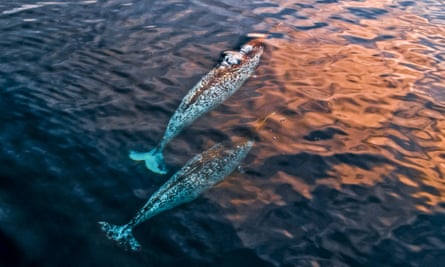Narwhals have been delaying their seasonal migration because of the impact of the climate crisis, suggesting an ability to adapt to the changing Arctic but increasing the risk that they may become trapped in ice, according to new research.
Narwhals, recognisable by their long spiralled tusk that has earned them the nickname “unicorns of the sea”, inhabit the Arctic waters of Greenland, Canada and Russia. They are a migratory species that spend summer months in ice-free coastal areas before moving to deeper waters between late September and mid-November.
Researchers from the University of Windsor, in Canada, examined satellite data from 1997 to 2018 from 40 narwhals to explore how they moved around the Canadian Arctic and when they left their summer grounds. They compared this data with local and regional changes in temperature and ice formation.
The findings suggest that narwhals have been delaying their migration by almost 10 days each decade, with a total of 17 days’ delay since 1997. Narwhals are also taking an average of about four extra days in the earliest phase of their migration transit, according to the study.
The patterns in the narwhals’ delayed departure match the sea ice trends in the area, said Courtney Shuert, the study’s author and a researcher at the University of Windsor. For instance, the scholars mention other research showing that the ocean surrounding the Canadian archipelago froze over approximately five days later a decade.
“There’s this general trend [towards delaying migration], but there’s also a lot of inter-annual flexibility, which highlights that they’re having this strategic approach to when they’re leaving and they’re tracking these broad-scale climate trends,” Shuert said.

Narwhals – which live to about 50 years, with some living up to 100 – are more susceptible to the impacts of the climate crisis because they take longer to genetically evolve than animals with shorter lifespans.
The suggestion that they are adapting to their changing environment was a positive sign, Shuert said. But it could also put the cetaceans at risk, especially as the climate changes and extreme weather events become more frequent.
Adapting to leaving the coast a little later each year could leave narwhals more vulnerable to getting trapped in “landfast ice” – sea ice that is attached to the coastline and prevents the animals surfacing for air. “If you’re a narwhal going off clues [about when] to leave, you might not be able to factor in these sudden somewhat random extreme events,” Shuert said. Entrapment in ice can kill hundreds of animals.
Delayed migration could also lead to more encounters with predators such as orcas, which can reach farther north, as well as ships able to access routes that would have previously been frozen over, the study concluded.
More research was needed to understand the impact of the change in migration patterns, Shuert said. “We still don’t really understand the downstream effects of this shift.”
The study’s findings add to research about how climate change is altering animal migratory patterns – a phenomenon that has also appeared among birds and terrestrial mammals.
“The rate of change that we’re seeing now in the Arctic is a huge concern for a lot of animals because it could exceed how quickly the animals can adapt through evolution,” said Shuert. “But [these findings] really show this idea of behavioural flexibility and how important it can be to bolster these populations against change.”
